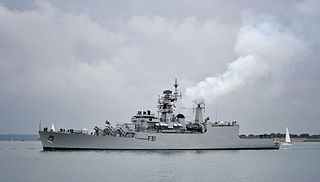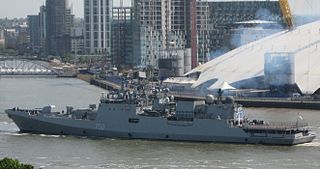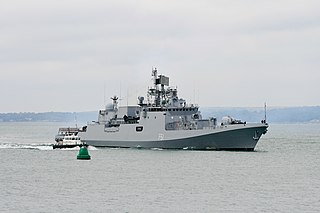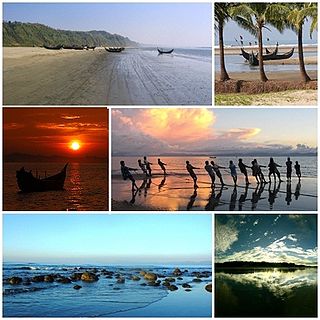
HMS Amazon was the first Type 21 frigate of the Royal Navy. Her keel was laid down at the Vosper Thornycroft shipyard in Southampton, England. The ship suffered a fire in the Far East in 1977, drawing attention to the risk of building warships with aluminium superstructure.

The Brahmaputra-class frigates are guided-missile frigates of the Indian Navy, designed and built in India. They are an enhancement of the Godavari class, with a displacement of 3850 tons and a length of 126 metres (413 ft). Although of similar hull and dimension, internally, the Brahmaputra and Godavari classes have different configurations, armaments and capabilities. 3 ships of this class serve in the Indian Navy.

INS Khukri was a British Type 14 (Blackwood-class) frigate of the Indian Navy. She was sunk off the coast of Diu, Gujarat, India by the Pakistan Navy Daphné-class submarine Hangor on 9 December 1971 during the Indo-Pakistani War of 1971. This was the first warship sunk in action by a submarine since the Korean War. It remains the post-Independence Indian navy's only warship to be lost in war to date.
The Nilgiri-class frigates were updated versions of the Leander class, designed and built for the Indian Navy by Mazagon Dock Limited in Mumbai. Six ships were built between 1972–81. Vessels of the class formed the 14th Frigate Squadron. The lead ship INS Nilgiri was the first major warship to be built in India in collaboration with Yarrow Shipbuilders of the United Kingdom.

The Godavari-class frigates are guided-missile frigates of the Indian Navy. The Godavari class was the first significant indigenous warship design and development initiative of the Indian Navy. Its design is a modification of the Nilgiri class with a focus on indigenous content of 72%, a larger hull and updated armaments.

INS Brahmaputra (F31) is the lead ship of her class of guided missile frigates of the Indian Navy. She was built at the Garden Reach Shipbuilders and Engineers (GRSE), Kolkata.

HMS Jaguar (F37), was a Leopard-class Type 41 anti-aircraft frigate of the British Royal Navy, named after the jaguar. Jaguar was the last frigate built by William Denny and Brothers for the Royal Navy. Unlike the rest of her class, she was fitted with controllable pitch propellers.

Goa Shipyard Limited (GSL) is an Indian Government owned ship building company located on the West Coast of India at Vasco da Gama, Goa. It was established in 1957, originally by the colonial government of the Portuguese in India as the "Estaleiros Navais de Goa", to build barges to be used in Goa's growing mining industry, which took off after the establishment of India's blockade of Goa in 1955. In the wake of Portugal's defeat and unconditional surrender to India following the 1961 Indian annexation of Goa, it was requisitioned to manufacture warships for the Indian Navy and the Indian Coast Guard.

INS Godavari (F20) was the lead ship of her class of guided-missile frigates of the Indian Navy. Built by Mazagon Dock Limited in Mumbai, she was the first Indian warship to be indigenously designed and built. She was commissioned on 10 December 1983, and decommissioned on 23 December 2015 after a 32-year career.

The NRP Afonso de Albuquerque was a warship of the Portuguese Navy, named after the 16th-century Portuguese navigator Afonso de Albuquerque. She was destroyed in combat on 18 December 1961, defending Goa against the Indian Armed Forces Annexation of Goa.
The Indian Army had no standby force ready in 1971 with the specific task of attacking West Pakistan, one of the many reasons why India did not immediately intervene after Pakistan launched Operation Searchlight in March 1971. Indian Army Eastern Command was tasked with defending the northern and eastern borders and fighting the insurgencies in Nagaland, Mizoram and Naxalites in West Bengal at that time. Mukti Bahini, aided by the Indian army through Operation Jackpot, led the struggle against the Pakistan army while the Indian army readied for intervention. General M. A. G. Osmani, Commander in Chief Bangladesh Forces, had divided Mukti Bahini forces into 11 geographical sectors for command and control purpose. Mukti Bahini forces numbered 30,000 regular soldiers and at least 100,000 guerrillas by December 1971. The Indian Army Eastern Command assembled two existing infantry corps, the IVth and the XXXIIIrd, for operations in Bangladesh, and created a new corps (II) besides reorganising the 101st Communication Zone as a combat formation. On 21 November 1971, Indian and Bangladesh forces were put under a joint command structure, led by Lt. Gen. Jagjit Singh Aurora, and this force came to be known as Mitro Bahini. In addition to 29 BSF battalions, Mukti Bahini guerrillas operating near the border or awaiting deployment in camps inside India were organised into infantry companies and attached to various Indian formations.

INS Beas (F37) is a Brahmaputra-class frigate of the Indian Navy. She was built at the Garden Reach Shipbuilders and Engineers (GRSE), Kolkata.
The following ships of the Indian Navy have been named INS Beas:

INS Tarkash (F50) is the second Talwar-class frigate constructed for the Indian Navy. She is part of the second batch of Talwar-class frigates ordered by the Indian Navy. She was built at the Yantar shipyard in Kaliningrad, Russia. She was commissioned to Navy service on 9 November 2012 at Kaliningrad and joined the Western Naval Command on 27 December 2012.

INS Trikand (F51) is a Talwar-class frigate of the Indian Navy. She is the third and final ship of the second batch of Talwar-class frigates ordered by the Indian Navy. She was built by the Yantar shipyard in Kaliningrad, Russia. She was commissioned to Indian Navy service on 29 June 2013.
















